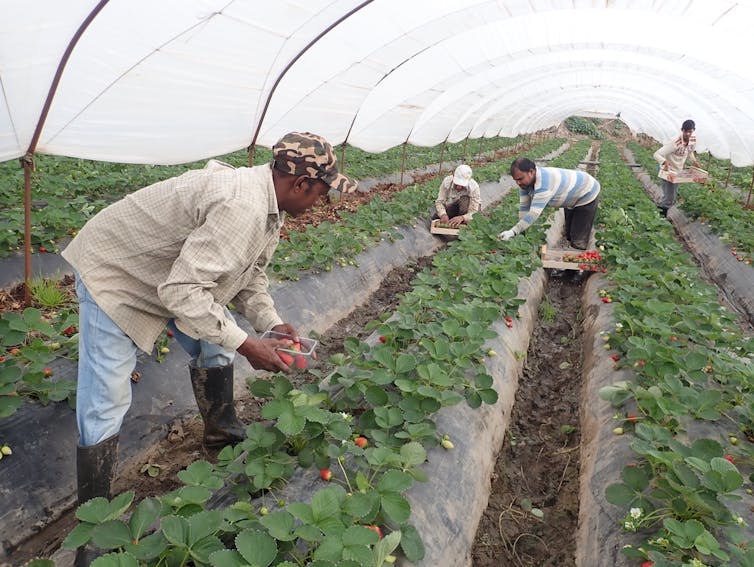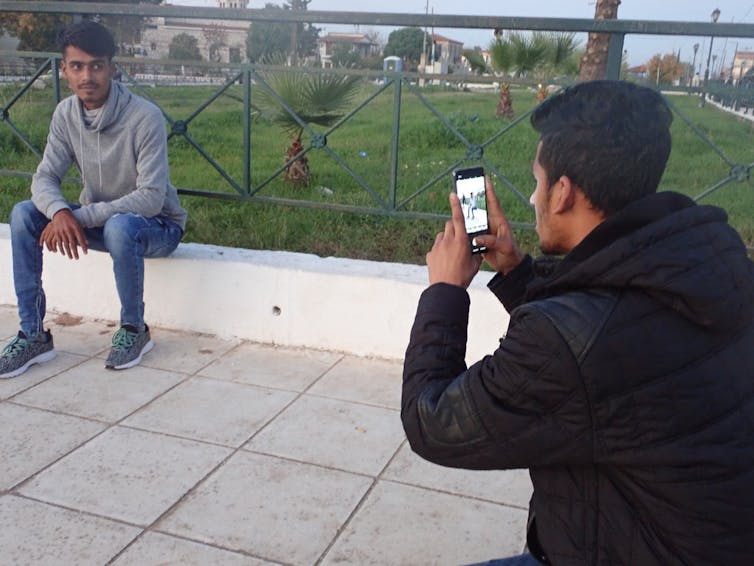Migrant workers are flipping the script and using Photovoice to tell their own stories
May 9, 2022
Share

What happens when undocumented Bangladeshi and Pakistani men in Greece pick up their cell phones to record their lives as migrant agricultural workers?
 ‚ÄúThis will let the people learn how we live our lives here,‚ÄĚ said one of the men, referring to the photos and videos they were taking. For the workers, these serve as evidence of their migrant existence.
‚ÄúThis will let the people learn how we live our lives here,‚ÄĚ said one of the men, referring to the photos and videos they were taking. For the workers, these serve as evidence of their migrant existence.
COVID-19 and worries about food security have resulted in increased media coverage about , with stories usually told on . Four sets of South Asian migrant men in Greece wanted to flip the script and tell their own stories.
They used , to present themselves and their concerns directly to people. This eventually transformed into a travelling multi-media exhibition , This is Evidence.
Long hours, low wages
Each year, thousands of young South Asian men arrive in , often driven by poverty, climate change, political unrest, or ethnic or religious violence in their home countries. Undocumented and hence ‚Äúillegal,‚ÄĚ they end up in Greece‚Äôs agrarian and urban informal economy as . Despite 90 per cent of Greek agriculture being dependent on , they are paid low wages, face wage theft and are forced to work long hours without breaks.

Since 2017, I have been conducting research with many of these men to study how their ‚Äúillegality‚ÄĚ and shape and the men‚Äôs .
The process behind the exhibition emerged organically as the men used WhatsApp to send me images of their lives. I suggested the use of Photovoice so they could share their lives with a wider audience.
Photovoice is a participant-oriented visual research strategy used to collaborate with .
Participants take images of what they consider important and not what researchers wish to highlight. The photos are accompanied by texts that emerge through conversations among Photovoice participants. These narratives are often used to .
The unique insider perspective provided by Photovoice makes it highly valuable for and .
Sharing their thoughts
Three groups of Bangladeshi men employed in the strawberry agribusiness, and one group of Pakistani men engaged in the informal economy in Athens, formed separate WhatsApp groups, including me in each. The groups were active from mid-2018 to late-2021.
They used their phones to take photos, to record video and voice messages about the precarity of life as migrant workers. They also spoke of workplace injuries, sub-standard housing and worker . The ubiquity of cell phones made it easy to do without drawing attention to themselves.
Through this project, the men were able to communicate with each other and myself using WhatsApp groups as forums for discussion. So their worries about being detained from gathering in one place, combined with unpredictable work hours, did not stop them from being able to document their experiences. This resulted in greater dialogue and collective decision-making.
The rules were simple: permission had to be granted from those photographed and all shared images implied fair use for exhibitions and other methods of awareness-generation

This is Evidence
Their work resulted in a multi-media exhibition I helped curate. We worked together to select images, videos, soundscapes and plan a replica of .
The exhibition, This is Evidence, was thematic, addressing border crossings, backbreaking labour, COVID-19 and activism. Quotes were selected from their voice messages and interviews.
The exhibition premiered in early April 2022 at Technopolis City of Athens. It will move on to Canada to venues such as Kingston, Ont., and .
While this project engages with a small set of migrant South Asian men in Greece, the visual articulation of their migrant experience resonates with other migrant workers across the world ‚ÄĒ including those employed under the Seasonal Agricultural Worker Program in agrarian communities across Canada.

This project challenges the stereotypes of migrant men, often vilified because of their . It also serves to empower by allowing the experiences of in Greece to reach a wider audience through multi-city exhibitions and the digital archive.
The men recognize that when it comes to being heard by ordinary people, policy and changemakers, many avenues are closed to them. This is Evidence serves as an accessible mode of communication. By disrupting their ‚Äú,‚ÄĚ the men seek to give voice and power back to racialized migrant workers. For them, this project is a political act of resistance.
‚ÄúWe participate to get our voice heard. We want change in the way people view us and our plight.‚ÄĚ![]()
_____________________________________________________
, Assistant Professor, Global Development Studies,
This article is republished from under a Creative Commons license. Read the .